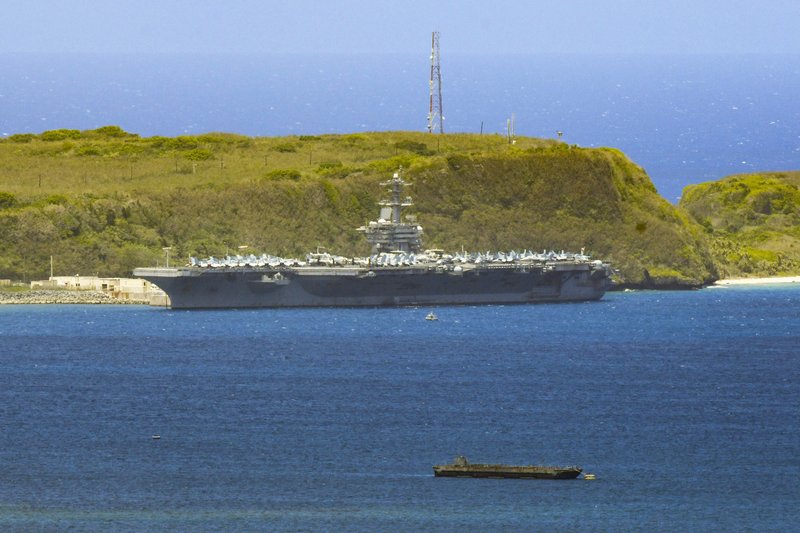A member of the crew of the coronavirus-infected USS Theodore Roosevelt died Monday of complications related to the disease, 11 days after the aircraft carrier’s captain was fired for pressing his concern that the Navy had done too little to safeguard his crew. The sailor was the first active-duty military member to die of COVID-19.
The sailor, whose name and other identifying information were not publicly released pending notification of relatives, had tested positive for coronavirus on March 30 and was taken off the ship and placed in “isolation housing” along with four other sailors at the U.S. Navy base on Guam. On April 9, he was found unresponsive during a medical check and was moved to a local hospital’s intensive care unit.
Over the weekend, four additional Roosevelt crew members were admitted to the hospital for monitoring of coronavirus symptoms, the Navy said. All are in stable condition and none are in intensive care or on ventilators.
The death Monday was the first among the crew of approximately 4,860, of which 585 had tested positive for coronavirus as of Monday. A little over 4,000 crew members have been moved ashore. A number have been kept aboard to attend to the enormous ship’s nuclear reactors and other sensitive systems.
The Navy’s top officer issued a statement of condolence.
“My deepest sympathy goes out to the family, and we pledge our full support to the ship and crew as they continue their fight against the coronavirus,” Adm. Mike Gilday, the chief of naval operations, said. “While our ships, submarines and aircraft are made of steel, sailors are the real strength of our Navy.”
Defense Secretary Mark Esper noted that the Roosevelt sailor was the first active-duty military member to die of coronavirus. One member of the New Jersey National Guard died of the virus in late March.
“We remain committed to protecting our personnel and their families while continuing to assist in defeating this outbreak,” Esper said in a statement.
The Roosevelt has been in a coronavirus crisis that prompted the Navy’s civilian leader, Thomas Modly, to fire the ship’s captain on April 2. Five days later, after having flown to the ship and delivered a speech in which he insulted the skipper, Capt. Brett E. Crozier, and criticized the crew for supporting Crozier, Modly resigned.
Modly said he felt compelled to remove Crozier from command because he had distributed too widely via email a letter in which he called for more urgent Navy action to prevent a deeper coronavirus crisis aboard his ship. Crozier’s words angered Modly but were seen by others as necessary.
“We are not at war. Sailors do not need to die. If we do not act now, we are failing to properly take care of our most trusted asset – our sailors,” Crozier wrote March 31. The letter appeared a short time later in the San Francisco Chronicle and other news media. Modly said the letter was inappropriate and that Crozier had failed to consult sufficiently with his immediate superior before writing it.
President Donald Trump initially criticized Crozier for writing the letter but later said he didn’t want Crozier’s career ruined over a single mistake.
Navy officials have not ruled out the possibility of Crozier being reinstated.
Adm. Robert Burke, the Navy’s second-ranking admiral, conducted a preliminary inquiry into the Roosevelt’s coronavirus outbreak and related events. Cmdr. Nate Christensen said Monday that Gilday has received and is reviewing Burke’s inquiry report. Christensen, spokesman for Gilday, said it would “take time” for the admiral to review and endorse the report.
Pentagon leaders anticipate that the coronavirus may strike more Navy ships at sea.
Last Thursday, Air Force Gen. John Hyten, vice chairman of the Joint Chiefs of Staff, noted that ships with large numbers of sailors aboard operating in close quarters are vulnerable to an outbreak, although the Roosevelt is the only one so far to have reported coronavirus cases while deployed at sea.
“It’s not a good idea to think that the Teddy Roosevelt is a one-of-a-kind issue,” Hyten told a Pentagon news conference. “We have too many ships at sea. … To think that it will never happen again is not a good way to plan.”
Gilday, meanwhile, said last week that the biggest problem is the inability to test enough people quickly, including those aboard the USS Nimitz, the next U.S.-based aircraft carrier due to deploy out to sea.
“The challenge that we have now, is having that type of capability where we can test in volume and at speed,” Gilday said Thursday. “I really don’t have a good estimate right now on when that testing capability might be available in the kinds of quantities we would like to see.”
He said sailors on the USS Nimitz, which is in port preparing for a deployment, will have all movement restricted for two weeks before the ship leaves.
(AP)











